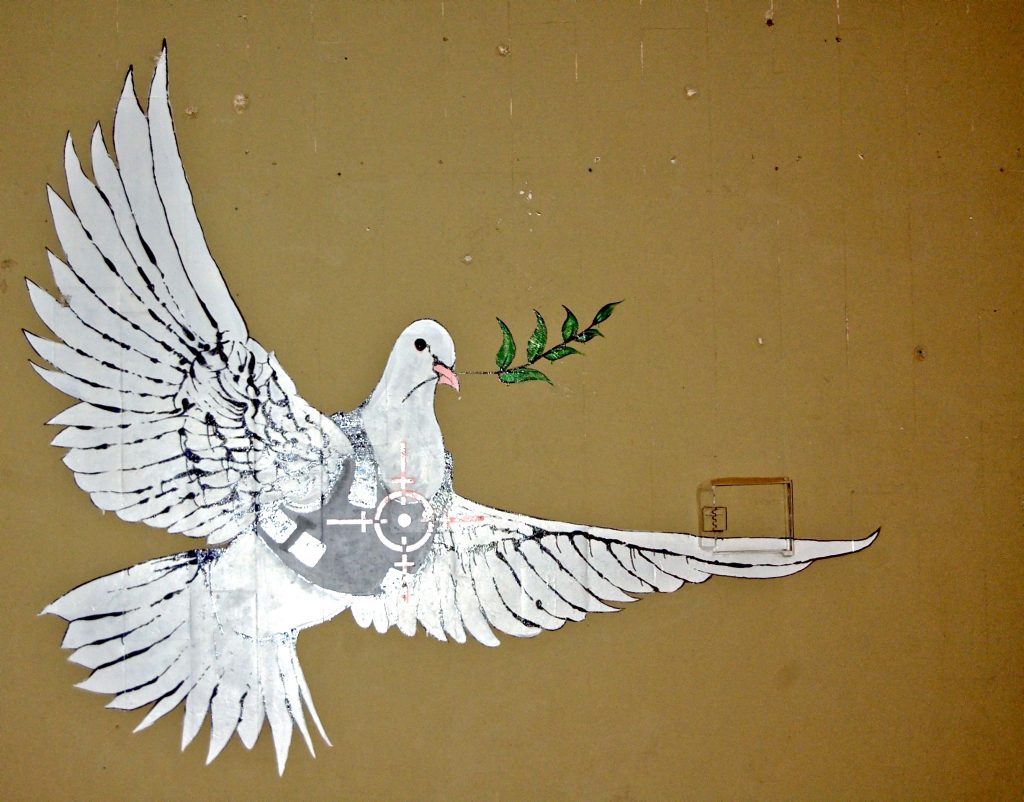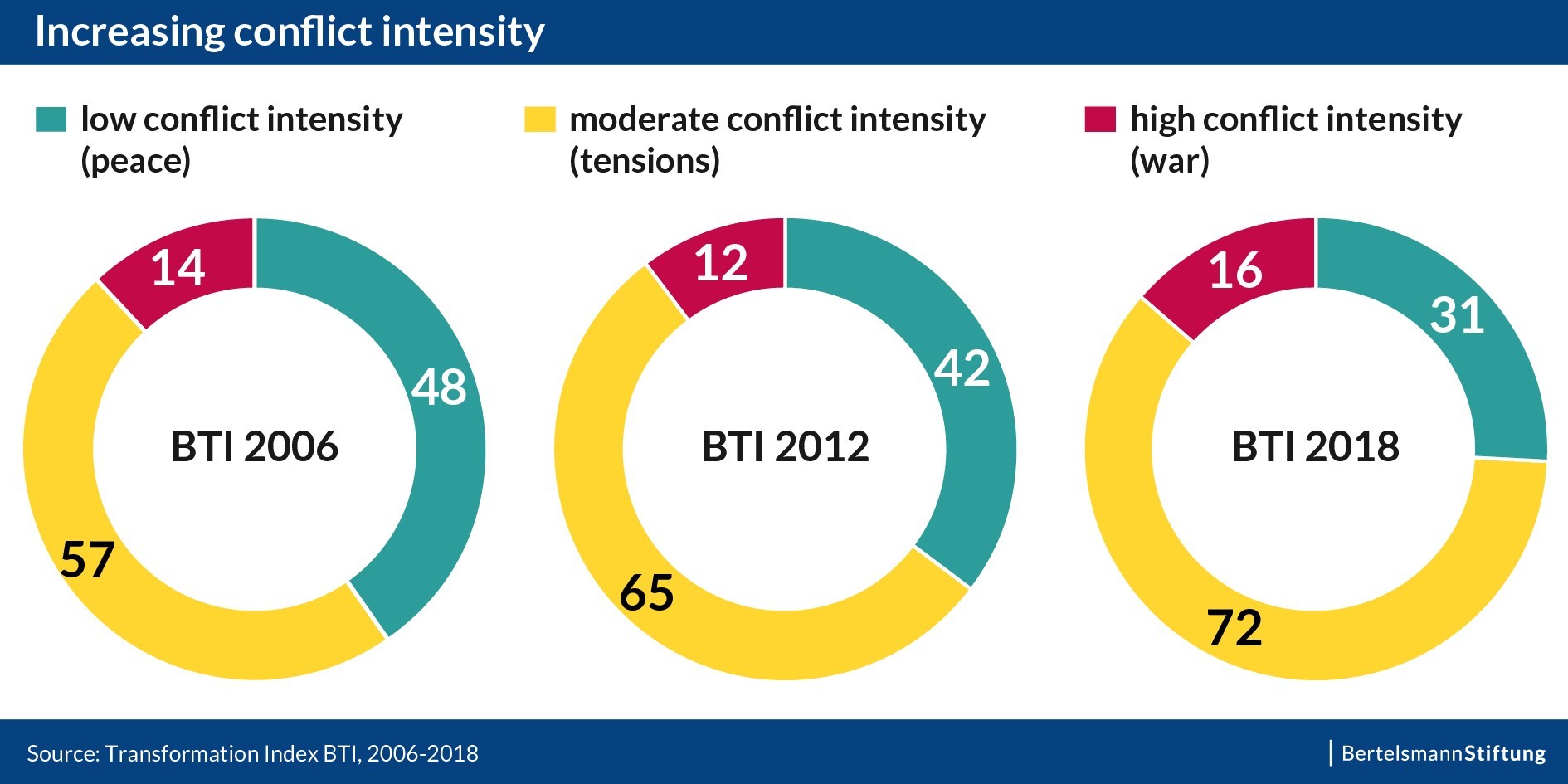Peace on Earth? Conflict intensity on the rise worldwide
Every year it is an unfulfilled Christmas promise, not only for the approximately 30% of the world’s population of Christian faith: that conflicts may rest and peace may return. However, not only do wars, civil wars and political violence continue to be widespread throughout the world. Measured by long-term trends, the number of war and assault victims was at a historically low level by the turn of the century, but in the last ten years, there has been a trend reversal towards more political violence. It is moreover significant that, on a global average, social tensions below the threshold of manifest violence have risen continuously in this decade. This is what the BTI blog is focusing on this week: why is conflict intensity on the rise, which factors are driving increasing polarization, which countries are particularly affected?
The intensity of social, political, ethnic and religious conflicts has increased steadily and significantly in recent years. On average, conflict intensity increased by 0.50 points on a scale of ten for all 119 states examined in the BTI 2006, which constitutes an extraordinarily strong increase for a global average score. This confirms the European perception of a “world out of joint” in view of an increasingly violent and conflict-prone neighbourhood and therefore requires a qualification: the number of countries in which war is being waged or in which political violence is massive and widespread (high conflict intensity: 8-10 points) has risen only slightly in recent years. In parallel with escalations of recent years such as in Libya or Syria, there have also been successful pacifications such as in Côte d’Ivoire or Liberia, which, however, receive less attention in Europe.
There are not many more wars than at the beginning of the century. Rather, in almost all regions of the world the rise in conflict intensity is due to increasing polarization and growing tensions within society, which can be the precursor to open hostilities. Such increases have been observed in Egypt or Mexico during this decade, for example, or more recently in Brazil, Mozambique and Turkey. While twelve years ago, social, ethnic or religious tensions were still rated at a very low level in about 40 percent of countries (low conflict intensity: 1-3 points), the figure in the BTI 2018 is only 26 percent. In between there are now 72 states in which social cleavages have become much more pronounced, even though the extent of manifest political violence is still limited (average conflict intensity: 4-7 points).
Why has conflict intensity increased so sharply worldwide in recent years? The BTI 2018 identifies three main trends:
For one, an increasing number of governments no longer responds effectively to growing domestic tensions. In many countries, protests against mismanagement, inefficiency (especially regarding the lack of a coherent anti-corruption policy) and a system of patronage are generally mobilized along existing ethnic, religious or social cleavages. Every so often, elites in these countries even instrumentalize these cleavages to foster polarization and the consolidation of their power. In such a context, increasingly few on all sides demonstrate a willingness or ability to engage in dialogue.
Secondly, the fall in commodity prices put pressure on many export-dependent economies, resulting in a decline of economic performance and macroeconomic stability in one third of the 129 countries surveyed. Many elites have failed to respond to global challenges with economic policies that ensure stability and social inclusion. In 72 countries, poverty and inequality are strongly pronounced and persistent. Within the last ten years, the share of BTI countries achieving a moderate to good level of social inclusion has fallen from one-third to one-fourth.
Finally, the long-term trend of increasing restrictions on political freedoms and the rule of law continues unabated. While in recent years this was primarily due to greater repression in hardening autocracies, the BTI 2018 identifies above all some relatively advanced transformation countries whose governments are showing a more authoritarian leaning. The deficient responsiveness of governments against the background of social exclusion and a lack of economic prospects has led to a crisis of confidence in the established political system and to the rise of populist parties in many countries.
Increasing conflict intensity can therefore not solely be attributed to already existing social tensions that are suddenly erupting violently. More often, it is also inadequate conflict management, and thus a massive failure of governments to de-escalate and build consensus, that is behind the sharp increase in polarization and political violence. In the coming days, another blog article will be published on this subject, which will address the causes of inadequate conflict management, identify the worst performers and particularly affected regions, and highlight successful examples of de-escalation, reconciliation and consensus-building.
As a result of these trends, 46 of the 129 countries surveyed in the BTI 2018 rank between 6 and 10 points on a scale of ten with regard to the intensity of their intra-societal conflicts, ranging from strong polarization with isolated outbreaks of violence as in Colombia or Indonesia to massive and widespread violence as in Libya or Yemen. In one third of all developing and transition countries, and especially in many African countries, the population thus lives in a violent environment – truly no peace on earth.
Continue reading Peace on Earth? The quality of conflict management is in decline




Thanks for the information and very useful 🙂